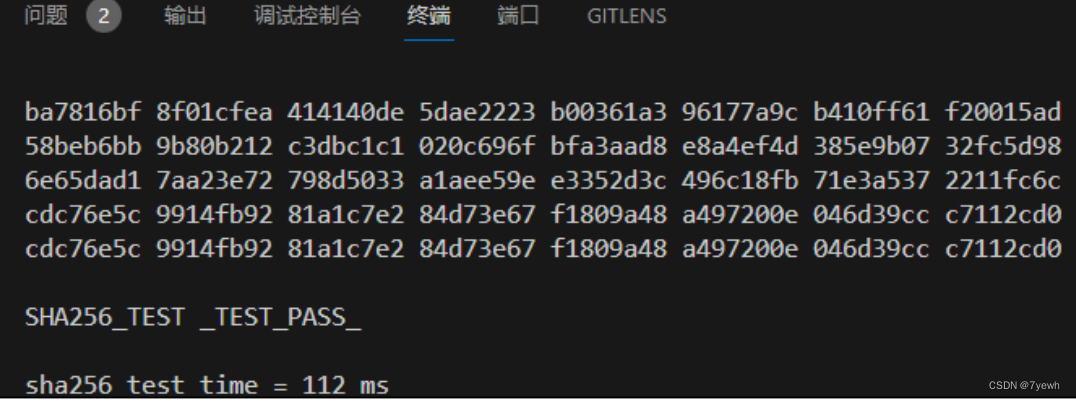1、SHA256****介绍
SHA256 加速器是用来计算 SHA-256 的计算单元, SHA256 是 SHA-2 下细分出的一种算法。
SHA-2 名称来自于安全散列算法 2 (英语: Secure Hash Algorithm 2 )的缩写,一种密码散列函
数算法标准,由美国国家安全局研发,由美国国家标准与技术研究院( NIST )在 2001 年发布。
属于 SHA 算法之一,是 SHA-1 的后继者。其下又可再分为六个不同的算法标准,包括了:
SHA-224 、 SHA-256 、 SHA-384 、 SHA-512 、 SHA-512/224 、 SHA-512/256 。这些变体除了生成摘要的长度、循环运行的次数等一些细微差异之外,基本结构是一致的。
简单来说,对于任何长度的消息, SHA256 都会产生一个 256bit 长的哈希值。
Kendryte K210 内置 SHA256 (安全散列算法加速器)功能包括:
- 支持 SHA-256 的计算
- 支持输入数据的 DMA 传输
Kendryte K210 官方 SDK 提供了 3 个操作 PWM 的函数,这些函数介绍如下:
sha256_init 函数:
该函数主要用于初始化 SHA256 加速器外设,该函数原型及参数描述如下所示:
cpp
void sha256_init(sha256_context_t *context, size_t input_len);
typedef struct _sha256_context
{
size_t total_len;
size_t buffer_len;
union
{
uint32_t words[16];
uint8_t bytes[64];
} buffer;
} sha256_context_t;sha256_update 函数:
该函数用于传入一个数据块参与 SHA256 Hash 计算,如下代码所示:
cpp
void sha256_update(sha256_context_t *context, const void *input, size_t
input_len);该函数有三个参数,第一个参数为输入 SHA256 上下文对象,第二个参数为待加入计算的
SHA256 计算的数据块,第三个参数为对应数据块的长度。
sha256_final 函数:
该函数用于结束对数据的 SHA256 Hash 计算,如下代码所示:
cpp
void sha256_final(sha256_context_t *context, uint8_t *output);函数共有两个参数,第一个参数为输入 SHA256 上下文对象,第二个参数为存放 SHA256 计算的结果的 buffer ,需保证传入这个 buffer 的大小为 32Bytes 以上。
sha256_hard_calculate 函数:
该函数用于一次性对连续的数据计算它的 SHA256 Hash ,如下代码所示:
cpp
void sha256_hard_calculate(const uint8_t *input, size_t input_len, uint8_t
*output);该函数有三个参数,第一、第二参数用于输入待 SHA256 计算的数据和数据的长度,第三
个参数为存放 SHA256 计算的结果的 buffer ,需保证传入这个 buffer 的大小为 32Bytes 以上。
2、源码案例
main.c 如下所示:
cpp
uint8_t hash[SHA256_HASH_LEN];
uint8_t compare1[] = {0xba, 0x78, 0x16, 0xbf, 0x8f, 0x01, 0xcf, 0xea, 0x41, 0x41,
0x40, 0xde, 0x5d, 0xae, 0x22, 0x23,
0xb0, 0x03, 0x61, 0xa3, 0x96, 0x17, 0x7a, 0x9c, 0xb4, 0x10,
0xff, 0x61, 0xf2, 0x00, 0x15, 0xad};
uint8_t compare2[] = {0x58, 0xbe, 0xb6, 0xbb, 0x9b, 0x80, 0xb2, 0x12, 0xc3, 0xdb,
0xc1, 0xc1, 0x02, 0x0c, 0x69, 0x6f,
0xbf, 0xa3, 0xaa, 0xd8, 0xe8, 0xa4, 0xef, 0x4d, 0x38, 0x5e,
0x9b, 0x07, 0x32, 0xfc, 0x5d, 0x98};
uint8_t compare3[] = {0x6e, 0x65, 0xda, 0xd1, 0x7a, 0xa2, 0x3e, 0x72, 0x79, 0x8d,
0x50, 0x33, 0xa1, 0xae, 0xe5, 0x9e,
0xe3, 0x35, 0x2d, 0x3c, 0x49, 0x6c, 0x18, 0xfb, 0x71, 0xe3,
0xa5, 0x37, 0x22, 0x11, 0xfc, 0x6c};
uint8_t compare4[] = {0xcd, 0xc7, 0x6e, 0x5c, 0x99, 0x14, 0xfb, 0x92, 0x81, 0xa1,
0xc7, 0xe2, 0x84, 0xd7, 0x3e, 0x67,
0xf1, 0x80, 0x9a, 0x48, 0xa4, 0x97, 0x20, 0x0e, 0x04, 0x6d,
0x39, 0xcc, 0xc7, 0x11, 0x2c, 0xd0};
uint8_t data_buf[1000*1000];
int main(void)
{
uint64_t cycle;
uint8_t total_check_tag = 0;
uint32_t i;
printf("\n");
cycle = read_cycle();
sha256_hard_calculate((uint8_t *)"abc", 3, hash);
for (i = 0; i < SHA256_HASH_LEN;)
{
if (hash[i] != compare1[i])
total_check_tag = 1;
printf("%02x", hash[i++]);
if (!(i % 4))
printf(" ");
}
printf("\n");
sha256_hard_calculate((uint8_t
*)"abcdefghijabcdefghijabcdefghijabcdefghijabcdefghijabcdefghij", 60, hash);
for (i = 0; i < SHA256_HASH_LEN;)
{
if (hash[i] != compare2[i])
total_check_tag = 1;
printf("%02x", hash[i++]);
if (!(i % 4))
printf(" ");
}
printf("\n");
sha256_hard_calculate((uint8_t
*)"abcdefghabcdefghabcdefghabcdefghabcdefghabcdefghabcdefghabcdefgha", 65, hash);
for (i = 0; i < SHA256_HASH_LEN;)
{
if (hash[i] != compare3[i])
total_check_tag = 1;
printf("%02x", hash[i++]);
if (!(i % 4))
printf(" ");
}
printf("\n");
memset(data_buf, 'a', sizeof(data_buf));
sha256_hard_calculate(data_buf, sizeof(data_buf), hash);
for (i = 0; i < SHA256_HASH_LEN;)
{
if (hash[i] != compare4[i])
total_check_tag = 1;
printf("%02x", hash[i++]);
if (!(i % 4))
printf(" ");
}
printf("\n");
sha256_context_t context;
sha256_init(&context, sizeof(data_buf));
sha256_update(&context, data_buf, 1111);
sha256_update(&context, data_buf + 1111, sizeof(data_buf) - 1111);
sha256_final(&context, hash);
for (i = 0; i < SHA256_HASH_LEN;)
{
if (hash[i] != compare4[i])
total_check_tag = 1;
printf("%02x", hash[i++]);
if (!(i % 4))
printf(" ");
}
printf("\n");
cycle = read_cycle() - cycle;
if (total_check_tag == 1)
printf("\nSHA256_TEST _TEST_FAIL_\n");
else
printf("\nSHA256_TEST _TEST_PASS_\n");
printf("\nsha256 test time = %ld ms\n",
cycle/(sysctl_clock_get_freq(SYSCTL_CLOCK_CPU)/1000));
while(1);
return 0;
}可以看到,mian 函数首先计算' abc '的哈希值,并将计算的值通过串口打印输出,接着
计算字符串" abcdefghijabcdefghijabcdefghijabcdefghijabcdefghijabcdefghij "的哈希值,然后同样
将计算的值打印出来,然后计算字符串" abcdefghabcdefghabcdefghabcdefghabcdefghabcdefghabc
defghabcdefgha "的哈希值并打印输出,接着计算多个字符' a '和分块计算多个字符' a '的哈
希值,然后通过串口打印输出。
至此,该函数总共输出 5 个不同的消息经过 SHA256 算法计算后得到的、各为 32 字节长度
的哈希值。
